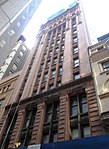Museum of American Finance

The Museum of American Finance is the United States's only independent public museum dedicated to preserving, exhibiting and teaching about American finance and financial history. Located in the Financial District in Manhattan, New York City, it is an affiliate of the Smithsonian Institution. It is a tax-exempt 501(c)(3) organization chartered by the Board of Regents of the New York State Department of Education. With education at the core of its mission, it is an active national-level advocate on behalf of financial literacy. The museum was founded in 1988 as the Museum of American Financial History but was renamed the Museum of American Finance in 2005. Until December 2006, it was located at 26 Broadway. On January 11, 2008, the Museum opened in a new location at 48 Wall Street, the former headquarters of the Bank of New York. In 2018, their building experienced a flood and as of late 2020, they remain in search of a permanent home.
Excerpt from the Wikipedia article Museum of American Finance (License: CC BY-SA 3.0, Authors, Images).Museum of American Finance
Wall Street, New York Manhattan
Geographical coordinates (GPS) Address Nearby Places Show on map
Geographical coordinates (GPS)
| Latitude | Longitude |
|---|---|
| N 40.706388888889 ° | E -74.009166666667 ° |
Address
Bank of New York Building
Wall Street 48
10005 New York, Manhattan
New York, United States
Open on Google Maps










